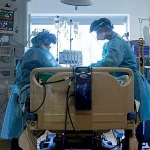
HANOVER, N.H. (WCAX) – A first-of-its-kind symposium Wednesday at Dartmouth College explored both the potential benefits and pitfalls of artificial intelligence in health care.
Dr. Curt Langlotz, a professor at Stanford, is a leader in the AI field, investigating how machine learning is getting better at detecting diseases, specifically when it comes to reading X-rays and other scans.
“Showing people the promise with AI and well as some of the challenges and risks that we will see over time,” Langlotz told a room of fellow clinicians and biomedical researchers at Dartmouth’s one-day symposium, “AI in Medicine: Bridging Innovation and Practice.”
He says that because of AI’s ability to extract and analyze huge quantities of data, it’s making health care as a whole more precise. “We will see AI assisting caregivers, nurses, doctors and in fact assisting patients in understanding their health care information,” Langlotz said.
“More accurate, more efficient, more accessible to all,” said Saeed Hassanpour, the director of Dartmouth’s Center for Precision Health and Artificial Intelligence, which helped organize the symposium along with the Dartmouth Cancer Center, and Geisel School of Medicine. “It’s actually going to improve efficiency, going to reduce health care costs. It is going to improve the accuracy.”
And it will be implemented across the world, including areas where access to health care remains a challenge. “Countries that have lower resources, they don’t always have the physician workforce that we have here in the United States,” Langlotz said.
But there are also ethical concerns with the technology, specifically around patient privacy and data security. But Langlotz says at this point, the good outweighs the bad. “Improving the quality of care, reducing medical errors,” he said.
College officials say they hope to make the symposium an annual event as the center of Precision Health and Artificial intelligence continues to grow.
